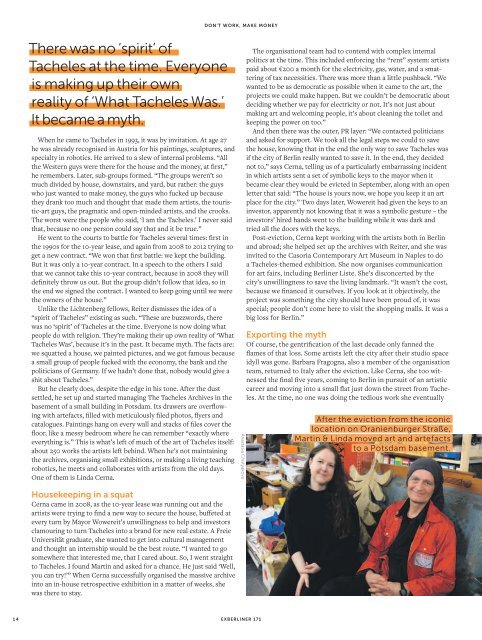You also want an ePaper? Increase the reach of your titles
YUMPU automatically turns print PDFs into web optimized ePapers that Google loves.
DON’T WORK, MAKE MONEY<br />
There was no ‘spirit’ of<br />
Tacheles at the time. Everyone<br />
is making up their own<br />
reality of ‘What Tacheles Was.’<br />
It became a myth.<br />
When he came to Tacheles in 1993, it was by invitation. At age 27<br />
he was already recognised in Austria for his paintings, sculptures, and<br />
specialty in robotics. He arrived to a slew of internal problems. “All<br />
the Western guys were there for the house and the money, at first,”<br />
he remembers. Later, sub-groups formed. “The groups weren’t so<br />
much divided by house, downstairs, and yard, but rather: the guys<br />
who just wanted to make money, the guys who fucked up because<br />
they drank too much and thought that made them artists, the touristic-art<br />
guys, the pragmatic and open-minded artists, and the crooks.<br />
The worst were the people who said, ‘I am the Tacheles.’ I never said<br />
that, because no one person could say that and it be true.”<br />
He went to the courts to battle for Tacheles several times: first in<br />
the 1990s for the 10-year lease, and again from 2008 to 2012 trying to<br />
get a new contract. “We won that first battle: we kept the building.<br />
But it was only a 10-year contract. In a speech to the others I said<br />
that we cannot take this 10-year contract, because in 2008 they will<br />
definitely throw us out. But the group didn’t follow that idea, so in<br />
the end we signed the contract. I wanted to keep going until we were<br />
the owners of the house.”<br />
Unlike the Lichtenberg fellows, Reiter dismisses the idea of a<br />
“spirit of Tacheles” existing as such. “These are buzzwords, there<br />
was no ‘spirit’ of Tacheles at the time. Everyone is now doing what<br />
people do with religion. They’re making their up own reality of ‘What<br />
Tacheles Was’, because it’s in the past. It became myth. The facts are:<br />
we squatted a house, we painted pictures, and we got famous because<br />
a small group of people fucked with the economy, the bank and the<br />
politicians of Germany. If we hadn’t done that, nobody would give a<br />
shit about Tacheles.”<br />
But he clearly does, despite the edge in his tone. After the dust<br />
settled, he set up and started managing The Tacheles Archives in the<br />
basement of a small building in Potsdam. Its drawers are overflowing<br />
with artefacts, filled with meticulously filed photos, flyers and<br />
catalogues. Paintings hang on every wall and stacks of files cover the<br />
floor, like a messy bedroom where he can remember “exactly where<br />
everything is.” This is what’s left of much of the art of Tacheles itself:<br />
about 250 works the artists left behind. When he’s not maintaining<br />
the archives, organising small exhibitions, or making a living teaching<br />
robotics, he meets and collaborates with artists from the old days.<br />
One of them is Linda Cerna.<br />
Anastasia Chistyakova<br />
The organisational team had to contend with complex internal<br />
politics at the time. This included enforcing the “rent” system: artists<br />
paid about €200 a month for the electricity, gas, water, and a smattering<br />
of tax necessities. There was more than a little pushback. “We<br />
wanted to be as democratic as possible when it came to the art, the<br />
projects we could make happen. But we couldn’t be democratic about<br />
deciding whether we pay for electricity or not. It’s not just about<br />
making art and welcoming people, it’s about cleaning the toilet and<br />
keeping the power on too.”<br />
And then there was the outer, PR layer: “We contacted politicians<br />
and asked for support. We took all the legal steps we could to save<br />
the house, knowing that in the end the only way to save Tacheles was<br />
if the city of Berlin really wanted to save it. In the end, they decided<br />
not to,” says Cerna, telling us of a particularly embarrassing incident<br />
in which artists sent a set of symbolic keys to the mayor when it<br />
became clear they would be evicted in September, along with an open<br />
letter that said: “The house is yours now, we hope you keep it an art<br />
place for the city.” Two days later, Wowereit had given the keys to an<br />
investor, apparently not knowing that it was a symbolic gesture – the<br />
investors’ hired hands went to the building while it was dark and<br />
tried all the doors with the keys.<br />
Post-eviction, Cerna kept working with the artists both in Berlin<br />
and abroad; she helped set up the archives with Reiter, and she was<br />
invited to the Casoria Contemporary Art Museum in Naples to do<br />
a Tacheles-themed exhibition. She now organises communication<br />
for art fairs, including Berliner Liste. She’s disconcerted by the<br />
city’s unwillingness to save the living landmark. “It wasn’t the cost,<br />
because we financed it ourselves. If you look at it objectively, the<br />
project was something the city should have been proud of, it was<br />
special; people don’t come here to visit the shopping malls. It was a<br />
big loss for Berlin.”<br />
Exporting the myth<br />
Of course, the gentrification of the last decade only fanned the<br />
flames of that loss. Some artists left the city after their studio space<br />
idyll was gone. Barbara Fragogna, also a member of the organisation<br />
team, returned to Italy after the eviction. Like Cerna, she too witnessed<br />
the final five years, coming to Berlin in pursuit of an artistic<br />
career and moving into a small flat just down the street from Tacheles.<br />
At the time, no one was doing the tedious work she eventually<br />
After the eviction from the iconic<br />
location on Oranienburger Straße,<br />
Martin & Linda moved art and artefacts<br />
to a Potsdam basement.<br />
Housekeeping in a squat<br />
Cerna came in 2008, as the 10-year lease was running out and the<br />
artists were trying to find a new way to secure the house, buffeted at<br />
every turn by <strong>May</strong>or Wowereit’s unwillingness to help and investors<br />
clamouring to turn Tacheles into a brand for new real estate. A Freie<br />
Universität graduate, she wanted to get into cultural management<br />
and thought an internship would be the best route. “I wanted to go<br />
somewhere that interested me, that I cared about. So, I went straight<br />
to Tacheles. I found Martin and asked for a chance. He just said ‘Well,<br />
you can try!’” When Cerna successfully organised the massive archive<br />
into an in-house retrospective exhibition in a matter of weeks, she<br />
was there to stay.<br />
14<br />
EXBERLINER <strong>171</strong>

















